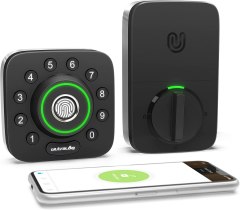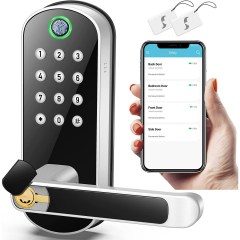
This smart biometric door lock has an app control system for smooth settings changes.
This smart biometric door lock has an app control system for smooth settings changes.
There are 6 ways to unlock it: using a PIN code, a biometric fingerprint reader, the smartphone app, QR code, voice control with Amazon Alexa or Google Assistant, and a physical key if things go wrong. It comes in 3 colors (matte black, satin nickel, and Venetian bronze).
Some had issues connecting their digital assistant so they could use voice commands on the lock.

Easy to use and maintain, simply follow along with the included voice guide to operate this device.
Easy to use and maintain, simply follow along with the included voice guide to operate this device.
Access with fingerprint, card, or code. The fingerprint sensor uses 3D software for quickness and accuracy. Additional deadbolt button. Combination of OLED screen and voice guide for easy installation.
Not as waterproof as other models, so may require an addition layer of coverage.

This lock integrates several methods of entry that users can customize to their preferences.
This lock integrates several methods of entry that users can customize to their preferences.
Offers 6 different methods of unlocking. The scanner identifies fingerprints from all angles. Automatically locks, allowing for hassle-free exits. Withstands high temperatures and harsh weather conditions.
Some concerns with the longevity of the fingerprint scanner.

With several layers of exterior protection, this lock secures your house during all seasons.
With several layers of exterior protection, this lock secures your house during all seasons.
The fingerprint scanner identifies you within a second. Includes a security app for controls and customizations. The built-in sensor automatically locks the door when shut. Protects against harsh weather.
Does not have the ability to connect to WiFi.

This lock is smart enough to be controlled by your phone but has a key unlock if the power goes out.
This lock is smart enough to be controlled by your phone but has a key unlock if the power goes out.
If you have a Sifely WiFi Gateway you can access extra features such as locking and unlocking it from anywhere and being able to see real-time access logs. Installation is quick and easy, plus all you need is a screwdriver.
It shouldn’t be used for outdoor access because the weather can wear it down fast.

We recommend these products based on an intensive research process that's designed to cut through the noise and find the top products in this space. Guided by experts, we spend hours looking into the factors that matter, to bring you these selections.

It’s never been more important to protect the security of your home and business, and biometric door locks offer the most advanced method of access management possible. These devices allow unrivaled control over who can and cannot gain entry, and they are almost impossible to hack. In addition, many biometric locks can log activity for later analysis, and some can be controlled remotely by smartphone.
There are plenty of choices and models to suit a variety of budgets and needs, but descriptions aren’t always clear and jargon can be confusing. Designs vary a great deal, from the purely functional for work environments to the more attractive models for the home. A few advanced locks also offer fire detection alarms.
We at BestReviews can help you decide the right model for your needs with our in-depth look at the technology. Our product recommendations highlight the best options in terms of performance and value. The following buying guide gives a clear explanation of the features and benefits biometric door locks can deliver.

The most common definition of biometric is the use of biological data for personal identification. It is effective because certain aspects of every individual are unique: DNA is one example and another is the pattern on your retina. In the case of door locks (and other electromechanical devices), it’s your fingerprint.
Scanner: All biometric door locks include a fingerprint scanner. Depending on the memory, they can capture anywhere from 10 to 1,000 individual prints. An administrator has overall control (some locks allow more than one administrator) and can add or delete prints. A backlit scanner allows for easy access if it’s dark.
Keypad: In addition to fingerprint recognition, these locks offer several other access options. The most common is a keypad, with an individual PIN code provided with most models. This is more secure than providing everyone with the same code, and it might also allow for tracking. Smaller, more discreet door locks might only have a fingerprint scanner. Though frequently provided, there’s no reason a keypad should be necessary.
Anti-peep technology: An interesting extra with touchscreen keypads is anti-peep technology, which can take several forms. The problem is somebody looking over your shoulder when you enter the code. The most common solution is to add somewhere between two and six “false” characters before the true code, making it extremely difficult for an observer to remember. Seeing the code is virtually impossible on displays that show asterisks rather than numbers, or screens that randomly rearrange the number positions.
RFID: A further option is radio frequency identification (RFID), which uses the same kind of technology as contactless credit cards. The lock scans a chip embedded in a card or key fob, thereby providing access. It can be very convenient if your hands are full (the lock only requires relative proximity), though it isn’t as secure as restricting people to fingerprint or individual key code access.
Override: Some biometric door locks offer a “passageway” override, meaning that the door will stay unlocked until it is activated again. Depending on the system, this can be done remotely or by physical intervention. A few provide a proximity sensor and will sound an alarm if someone stands in front of the door without attempting to gain entry. These have proven effective at putting off the opportunist thief.
While it’s very unusual for the fingerprint scanner to fail, cheap biometric door locks often scan at lower resolution than more expensive models. Technically, this impacts what the industry calls the false recognition rate (FRR) and the false acceptance rate (FAR). Unfortunately, manufacturers almost never provide these figures. In real terms, it’s highly unlikely that an unauthorized person can gain access, but FRR can result in slower activation or repeated attempts before an authorized person is allowed in. There are no hard and fast rules, but in general, the more you spend, the less frequently these false readings happen. Top models can read your fingerprint even if your hand is wet, which could be particularly useful in properties with pools.
More complex biometric door locks can log who gains access and when and send the data to a smartphone. Some can connect to devices equipped with an RJ45 cable connector. Smartphone connectivity also opens up the opportunity to allow limited, one-time access regardless of where you are. A digital key can be sent to another phone, and the door operated via Bluetooth (which doesn’t rely on an available internet signal).
The power for a biometric door lock usually comes from batteries within the unit, and most will warn you if they’re going flat. Those units with electromagnetic locks need to be wired to household power. Almost all biometric door locks also have an override key, which can be used if there’s a fault or power failure.
Most biometric door locks are designed to replace existing door hardware, though heavy-duty models might offer additional security bolts. The specifications should quote a minimum and maximum door thickness, and you’ll need to check that the lock will fit.
Don’t forget your biometric door lock needs to be physically secure. It’s not much good if a burglar can simply jam a screwdriver in the handle and lever it open. Anti-tamper/pick-proof locks are popular. Note that a few biometric door locks have strong electromagnetic closures rather than physical latches or bolts.
Weatherproof: If you want to install your biometric door lock outside, make sure it is specified as such — many are not. If you live in a place that is particularly hot or cold, check the operating temperature parameters. Outdoor models sometimes have a sliding cover to provide weather protection and hide the fingerprint scanner and keypad until needed.
Inexpensive: The cheapest biometric door locks we found cost between $80 and $100. The effectiveness of the fingerprint scanner is often criticized — they can be slow or have trouble recognizing people.
Mid-range: There are a lot of very good devices in the $120 to $200 range. These are strong, secure, and reliable, just what most people need.
Expensive: Smartphone compatibility usually means you’ll pay $200 or more. External locks are also usually more expensive, as are some of the design-focused models from premium brands. High-end biometric door locks can cost over $400.
If the products in our matrix don’t suit, we found a few more. The AIGURD f18 Smart Lock is an affordable choice that provides good physical protection along with the biometrics. It also has anti-peep password protection, and providing the date and time is a nice touch. The Lockly PIN Genie Smart Door Lock is more compact than many, but it still has all the security you need. We particularly like the keypad that shuffles the numbers at random, making it almost impossible for someone to guess the code. It also stores up to 99 fingerprints and logs access history. The Samsung Push Pull Biometric Door Lock is a feature-packed model that offers keypad and RFID or fingerprint access, though perhaps the standout feature is the way the handle operates: push for entry, pull to exit. However, it is among the most expensive models.

Q. What happens to my biometric door lock if the power goes out?
A. Battery-operated models usually default to the locked position to maintain security. However, AC-powered internal models may default to open, so it’s worth checking. A key is usually provided for override access. On some, you can attach a 9-volt battery to restore function. As far as fingerprint and keypad memory is concerned, they should be retained, but we advise reading the product details to be sure.
Q. Are biometric door locks easy to install?
A. Most are quite simple, and it’s not unusual for them to be a straight replacement for an existing mechanism. Occasionally, a little drilling or minor work is required, but most people with moderate DIY skills won’t have any problems. Some manufacturers provide installation videos online. Magnetic locks require quite different fittings, and they have a power supply that needs to be wired into AC power. It’s not a particularly complex job, but it’s best to call in a professional if you’re in any doubt.
Q. Do I have to buy separate right- and left-handed door locks?
A. It varies. Some manufacturers provide handles that can be swapped. With others, it’s a question of buying right-handed or left-handed versions. You need to check when ordering.
Get emails you’ll love.
Learn about the products you’re wondering if you should buy and get advice on using your latest purchases.
